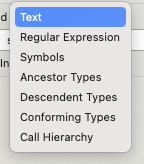

You don’t know Some Software Corp and their world famous website somesoftwarecorp.com?
Indie iOS app developer with a passion for SwiftUI


You don’t know Some Software Corp and their world famous website somesoftwarecorp.com?


But for iOS you’re forced to use Xcode for implementing certain things like permissions, build and upload.
You can do all that via VSCode as well if you so desire.
Permissions, configurations, etc. are essentially all just XML files and can be edited as such, building, running in simulator and uploading can all be done via CLI.
And if you’re not comfortable doing it via the terminal in VSCode, you can also find some extensions.
Personally as a native dev I don’t know why you’d want to of course, but to each their own.


I think you might be misunderstanding what this does.
You did a search for symbol references that contain “User” ignoring cases.
When you do a search for symbol references this way, Xcode will return two things:
And it did just that.
The first three .swift files show references to symbols that contain “User”.
The forth one, User.swift, is in and of itself a symbol that matches the query and has symbols inside itself.
The last one UserViewModel.swift is in itself a symbol as well and all the parts that are nested within that you’ve annotated with underscores and question marks, serve to give you context about the symbol “UserViewModel”, hence the ellipses.
It’s essentially telling you “Hey I’ve found this symbol UserViewModel, it starts with a var named username, has a bunch of stuff following that (i.e. …) then has an extension, then some more stuff (i.e. …) and then ends”.
Without knowing what’s inside UserViewModel.swift I can’t tell if it goofed with giving you a typical declaration, but that doesn’t change the fact that its trying to give you context about a valid search result, the symbol UserViewModel, so that you can figure out if that’s the one you’re looking for.
Keep in mind that variables are considered symbols as well, but in this instance I don’t think that’s what happened here, otherwise it would’ve been marked with a P instead of a C.
If this is not desired behavior then I suggest you switch from “Containing” to “Matching Word” or instead consider using the search bar at the bottom of the Symbol Navigator.
Another option, if you’re searching while going through code, is to right click on the symbol in your code and click Find > Find Selected Symbol in Workspace.
Lastly it might be an idea to go over the Xcode documentation as a refresher. This would be a good starting point.
That said, Apple clearly feels that things can be improved by clarifying, because in the current Xcode beta they’ve changed the option label from References to Symbols (and added a few more options).



Most of these services are US-centric because a lot of the necessary records to provide the information isn’t public in many countries outside of the US.
Birth records, death records, marriage records, divorce records, voting records, criminal records, etc. is considered public information in much of the US. Even address information can be found publicly and immigration records become available to the public after a certain time.
In a lot of countries, especially in many European countries, these are hard to access for people that aren’t the subject of these records, if accessible at all.
For example while court records are public in much of Europe, often times the names of private persons are censored because it’s not deemed necessary to know who the parties are to be able to check if the courts make fair decisions.
This automatically excludes criminal and divorce information from disseminating into the public.
Some countries will make some records public once the subject of those records have passed for X amount of years, but that’s still pretty rare.
As such services like these have limited use outside the United States.


Good instinct, here’s a BBC source.
Edit: Apparently this is old news? Or the news is that lawsuits have commenced?
USPS’ website does this, sort of.
If their text service is down it’ll let you know and just skip the 2FA process even though normally they offer an option to get the code via email.
The fact that they do this is bad enough, the fact that this happens so often that I’ve seen this at least a dozen times is even worse.